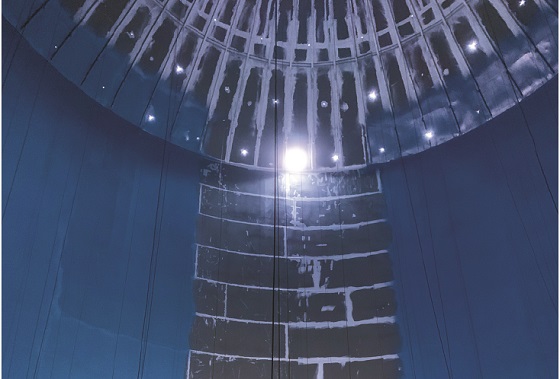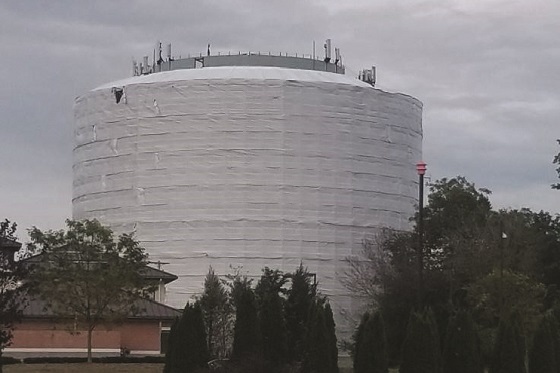Every second, 750,000 gallons (2.8 million L) of water flow over Niagara Falls. At that rate, it takes about 1.3 seconds for a million gallons to go over the falls. Now picture what 7.5 million gallons (28.4 million L) of water might look like, and imagine how big a steel tank would be needed to hold that amount of water. That is a huge tank!
Challenged from the Start
The Lafayette tank, a 7.5-million-gallon reservoir in the city of Lancaster, Pennsylvania, USA, is a steel potable water tank whose original coatings had reached the end of their life. City officials in Lancaster put the project out for public bid in late 2018, and the contract was awarded to U.S. Tank Painting (USTP) out of Millstone Township, New Jersey, USA. However, they were given a rather tight timeline in 2019 for such a large project. “We were given the contract in late July,” says Eric Houghton, vice president of USTP, “and we had a deadline of November 30 to put the tank into service. Our management team did an excellent job of coordinating the commencement of the project.”
In addition to the enormity of the tank and the compressed timeline, the coatings crew from USTP also had to install a full containment system to protect the surroundings from both blasting and painting operations. A subcontractor was hired to construct the scaffolding system around the tank, and then USTP crew attached 10-mil-thick (254.0-microns) Scaf-Lite plastic manufactured by Eagle Industries (New Orleans, Louisiana, USA).
The Work Begins
USTP had between eight and 10 crew members on the jobsite at any one time. The basic scope of the job was to blast the interior of the Lafayette tank with a steel grit recycler and then apply the lining system. The containment was then installed on the exterior, which was then blasted with a steel grit recycler and painted with a three-coat system.
Although the steel of the tank was in good condition, some minor repairs were needed, including new ladders and safety climb devices. All steel repairs were fabricated and provided by a third party. Sandblast Solutions, Inc. (SSI, Millstone Twp., New Jersey, USA) provided all the equipment for the project, including dust collectors, generators, recyclers, compressors, plural component spray trailer, fuel cube, decontamination trailer, dehumidifiers, and heaters.
Six USTP crew members used an Advanced Recycling Systems (ARS, Lowellville, Ohio, USA) steel grit recycler to blast the ~70,000-square-foot (6,503.2-m2) interior surface of the tank to a NACE No. 2/Society for Protective Coatings (SSPC) Surface Preparation (SP) 10, “Near-White Metal Blast.” The interior blast took approximately eight days, while blasting the 60,000-square-foot (5,574.2-m2) exterior took approximately 15 days.
One of the main environmental concerns while blasting, according to Houghton, was “to make sure all the spent abrasive and paint chips were captured within the containment system and that it was all contained and disposed of properly.” The ARS machine has “an actual vacuum also,” adds Sulkowski, “so it vacuums up the material. It separates the waste from the good grit, and we reuse the grit over and over again.”
That steel grit was a 50-50 mix of G-20 and G-50 from Ervin Industries (Ann Arbor, Michigan, USA). The crew was working to achieve a surface profile of 1.5 to 2.5 mils (38.1 to 63.5 µm) on both the interior and exterior steel surfaces, although the exterior received a NACE No. 3/SSPC-SP 6, “Commercial Blast Cleaning.”

During all blasting operations, USTP crew members wore blast hoods, breathing air lines, and blast suits. The job also required the use of safety harnesses, lanyards, hard hats, gloves, respiratory protection, safety glasses, and boots. Sulkowski says, “The protective breathing apparatus, the blast hoods, the filters, and the air breathing hoses are all made by RPB Safety [Royal Oak, Michigan, USA]. The half masks and full masks are all made by 3M [St. Paul, Minnesota, USA].”
Gimme Three Coats
Induron Protective Coatings (Birmingham, Alabama, USA) were chosen for the new systems for both the interior and exterior of the Lafayette steel tank. Induron, founded in 1947, offers a variety of ceramic-modified industrial coatings for markets including general corrosion protection, electrical transmission tower maintenance, industrial epoxy floor coating, specialty industrial finishes, and potable water tank paint.
Sulkowski explained the interior linings. It began with a primer coat of Indurazinc MC67, a single component, moisture-cured, aromatic urethane, organic zinc-rich primer. It was spray applied using a WIWA (Alger, Ohio, USA) pump and two WIWA Duomix 330 plural-component sprayers to a dry film thickness (DFT) of 2.5 to 3.5 mils (63.5 to 88.9 µm). This product provides galvanic protection for carbon steel substrates, and the dried film contains 83% zinc by weight. Then a stripe coat of PE-70 Epoxy was applied at 3 to 5 mils (76.2 to 127.0 µm) DFT. PE-70 is a two component, high-solids, modified self-priming epoxy coating formulated for resistance to water, water-borne chemicals, and other aggressive environments. Finally, the interior finish coat was Perma-Clean 100, spray applied at 20 to 25 mils (508.0 to 635.0 µm) DFT. Perma-Clean 100 is a solvent-free, immersion-grade, UL/NSF Standard 61 lining incorporating ceramic pigment into an amine-cured epoxy resin for maximum corrosion protection of immersed substrates. Occasionally, the crew used brushes and rollers for touch-ups.
The overall interior painting took nine days. Dehumidification equipment—a 5,000-cfm (141.6 m3/min.) unit—was utilized for climate control. Sulkowski says, “We used several Frost Fighter [Winnipeg, Manitoba, Canada] and Allmand [Holdrege, Nebraska, USA] heaters during painting to help ensure compliance and to help cure the coatings.”
The exterior was coated with the same primer at 2.5 to 3.5 mils DFT using a WIWA Herkules 75:1 unit with four sprayers going at once. An intermediate coat was the PE-70 Epoxy, only this time applied at 4 to 5 mils (101.6 to 127.0 µm) DFT. And the finish coat was Induron’s Perma-Gloss Fluorourethane, spray applied at a DFT of 2 to 4 mils (50.8 to 101.6 µm). Perma-Gloss Fluorourethane is a two-component, high-gloss, fluoropolymer resin-based urethane coating that contains a factory-added mildewcide that aids in fighting microbial growth. It is also available in a virtually unlimited color range, with the blue color “Basin” being used on this particular tank. Again, brushes and rollers were used as needed in addition to the spray unit. The crew spent 10 days applying the exterior coating system.
Continually Challenged
One of the challenges with the containment on the tank was the wind, according to Houghton. “The tank was extremely large,” he says. “Installing a full containment on such a large structure can be challenging, and we always have to be prepared for high winds. We had to replace the roof containment once and fix a few holes in the walls, but overall the containment withstood the constant winds extremely well. Wind and rain always affect projects, but we worked whenever we could and pushed the project.”
Sulkowski adds, “Winds are always a problem. The winds would come in there, and they can beat up the plastic or the containment. After they beat that up, we have to come in and do the repairs prior to continuing our blasting or painting on the exterior. So we had, a couple of times, some wind damage. But overall, it wasn’t too bad on that job.”
Having gotten a relatively late start on the tank, the USTP team was already up against a challenge. But there was more. “At the very end of the project,” Sulkowski recalls, “we got into some weather, so we kind of got slowed down. It’s such a massive tank that it pushed us into the winter season. Winter got cold quick…. We have to actually go back and finish the roof because the roof is only primed. So we’re going to do that [soon] because the weather is finally cooperating.”

Despite still having to apply the finish coat to the roof, the tank was ready to be put into service by November 30. “Yes, the tank was…ready to go by their deadline,” says Sulkowski. “They may have taken an extra week or so or a month to put it back in service. But it was ready to go.”
Satisfied Customers
Overall, Sulkowski, Houghton, and their team at USTP met the challenges of the massive job—the timeline, the tank’s size, the winds. USTP also installed the mixing system, “which was a little bit challenging on a size of tank that big,” says Sulkowski. A mixing system helps keep the water inside a storage tank from becoming stagnant when there isn’t a high demand placed on water usage.
“We had to get going on it quickly,” Sulkowski adds. “We got awarded it late. We did the job. We had to set up the job quickly. It was a little bit of challenge there, but it was a very nice size job, so we didn’t want to take the chance of not doing it, so we made it happen.”
And the city of Lancaster has a newly coated, 7.5-million-gallon tank to show for it—a tank that holds 10 times the amount of water that goes over Niagara Falls every second. “I believe they were satisfied,” says Sulkowski. “It seems like everybody was happy, and we were there the whole time. We were pushing it. We didn’t slow down at all. ... We did it with everything we had. I believe, in the end, it looks really good.”
This article was recently published in the MP’s May 2021 Tank Supplement. Reprinted with permission.